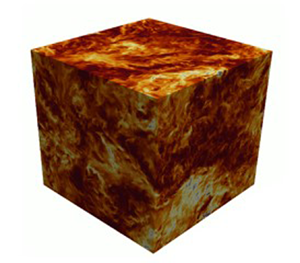Article contents
Tempered fractional LES modeling
Published online by Cambridge University Press: 02 December 2021
Abstract

The presence of non-local interactions and intermittent signals in the homogeneous isotropic turbulence grant multi-point statistical functions a key role in formulating a new generation of large-eddy simulation (LES) models of higher fidelity. We establish a tempered fractional-order modelling framework for developing non-local LES subgrid-scale models, starting from the kinetic transport. We employ a tempered Lévy-stable distribution to represent the source of turbulent effects at the kinetic level, and we rigorously show that the corresponding turbulence closure term emerges as the tempered fractional Laplacian,  $(\varDelta +\lambda )^{\alpha } (\cdot )$, for
$(\varDelta +\lambda )^{\alpha } (\cdot )$, for  $\alpha \in (0,1)$,
$\alpha \in (0,1)$,  $\alpha \neq \frac {1}{2}$ and
$\alpha \neq \frac {1}{2}$ and  $\lambda >0$ in the filtered Navier–Stokes equations. Moreover, we prove the frame invariant properties of the proposed model, complying with the subgrid-scale stresses. To characterize the optimum values of model parameters and infer the enhanced efficiency of the tempered fractional subgrid-scale model, we develop a robust algorithm, involving two-point structure functions and conventional correlation coefficients. In an a priori statistical study, we evaluate the capabilities of the developed model in fulfilling the closed essential requirements, obtained for a weaker sense of the ideal LES model (Meneveau, Phys. Fluids, vol. 6, issue 2, 1994, pp. 815–833). Finally, the model undergoes the a posteriori analysis to ensure the numerical stability and pragmatic efficiency of the model.
$\lambda >0$ in the filtered Navier–Stokes equations. Moreover, we prove the frame invariant properties of the proposed model, complying with the subgrid-scale stresses. To characterize the optimum values of model parameters and infer the enhanced efficiency of the tempered fractional subgrid-scale model, we develop a robust algorithm, involving two-point structure functions and conventional correlation coefficients. In an a priori statistical study, we evaluate the capabilities of the developed model in fulfilling the closed essential requirements, obtained for a weaker sense of the ideal LES model (Meneveau, Phys. Fluids, vol. 6, issue 2, 1994, pp. 815–833). Finally, the model undergoes the a posteriori analysis to ensure the numerical stability and pragmatic efficiency of the model.
- Type
- JFM Papers
- Information
- Copyright
- © The Author(s), 2021. Published by Cambridge University Press
References
REFERENCES
- 13
- Cited by





